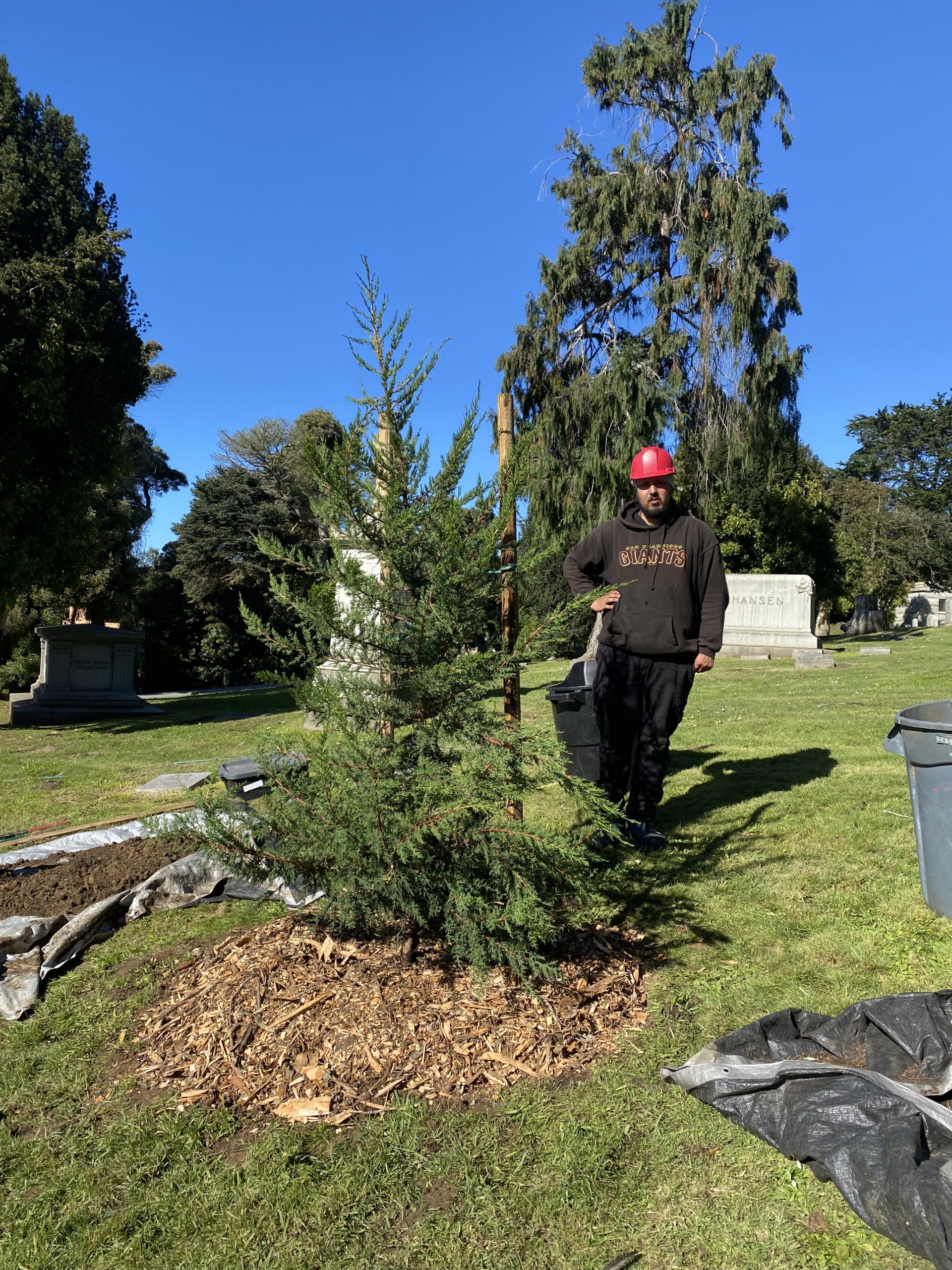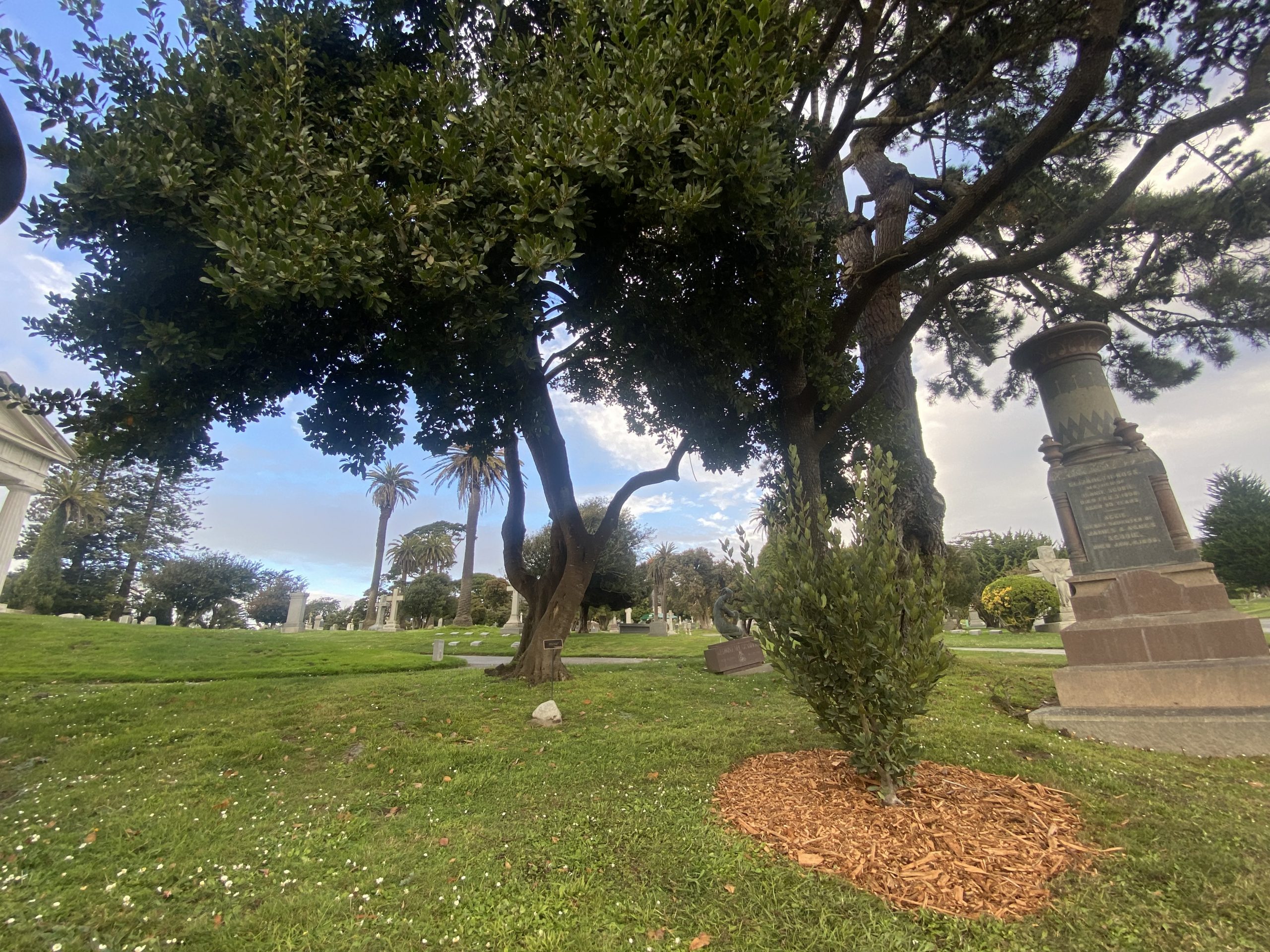Every November, in the annual celebration of life that is Arboretum Day, we plant trees here at Cypress Lawn. Just a couple of months ago, we planted a companion tree for one of our oldest veteran Monterey cypress specimens, photographed above. This young tree is one of many companions we introduced into our living collection of trees this past autumn.
Planting the next generation of seedlings and saplings throughout our original East Campus grows upon the legacy founded by Hamden Holmes Noble 130 years ago and helps to ensure that the landscape character of decades gone by is conserved and passed forward in stewardship for future visitors of our Memorial Park to enjoy.
 Our newly planted companions, and truly our champions too, began their lives as humble seeds, most likely in a tree nursery. From the start of this journey, and on through the growing processes of germination and development from seedling on to sapling, the time of a young tree in nursery care is a special part of the collaborative cultivation of healthy plants.
Our newly planted companions, and truly our champions too, began their lives as humble seeds, most likely in a tree nursery. From the start of this journey, and on through the growing processes of germination and development from seedling on to sapling, the time of a young tree in nursery care is a special part of the collaborative cultivation of healthy plants.
Nurseries provide young trees with ideal conditions for early growth, with special attention provided to give appropriate amounts of light, water, and nutrients during this vulnerable early life stage. Here at the Arboretum, we have our own small nursery that will surely expand in time, and we also have local and regional plant partners (most notably Devil Mountain Wholesale Nursery) that help us cultivate trees at their own facilities, for us to then plant into the future living landscape of Cypress Lawn.
Beyond the nursery, planting a young tree out into the landscape here at Cypress is really just the first step towards its establishment in the growing collection of the Arboretum. The establishment period is a sensitive time in the life of a young plant. For an arborist and tree steward, there are a few key principles of practice that are essential to the caregiving for this next generation.
First and foremost is water! Irrigation, or lack thereof, is a primary reason for new plantings to fail in the first year or two in their new home. The beginning of California’s rainy season in November allows for Mother Nature to be our ally in the establishment of young trees, and is another reason why we celebrate Arboretum Day and plant trees each November.

Still, consistent and appropriate amounts of human-assisted irrigation are essential when caring for new trees out on the grounds of Cypress. Generally speaking, a recent planting will receive one or two deep soaks of water each week, with perhaps more frequency during the summer drought months of May through October. Over time, as the years go by, our frequency of watering will decrease, while the volume of water provided in individual soaks of the root zone may increase.

Paying attention to the individual water needs of each tree is an ongoing process of awareness and sharing of available resources. Trees will indeed show signs of stress from lack of water by wilting and eventually dropping their leaves if we are not careful in our stewardship. But the joy of seeing a young tree become established in the landscape over the first couple of years after planting certainly makes it worth the effort!

Beyond water, oftentimes young trees that have not fully established their root system in the soil will benefit from a gentle boost in available nutrients — the stuff that life is made of! The addition of a slow-release fertilizer will provide new plantings with the macronutrients Nitrogen, Phosphorous, and Potassium (N+P+K), as well as smaller amounts of several micronutrients, all of which are essential for the continued growth of trees.
Plants will also show signs of a lack of nutrients to the attentive arborist or gardener, most commonly with a condition called chlorosis. This is a deficiency in leaves of the pigment chlorophyll, which is the energy machine that harvests sunlight from the environment and converts it into sugar that fuels plant growth. Often, when there is a lack of available nitrogen and other essential nutrients in the soil, the yellowing of leaves through chlorosis will become apparent. A gentle sprinkling of slow-release fertilizer, followed by another watering that releases the nutrients into the soil for the tree to uptake, may help a tree to grow onward and emerge from the visible symptoms of chlorosis. Once a plant has established and grown ample roots in its home, it may be that there are enough nutrients present just in the soil itself.

With these key practices of young plant cultivation at the Arboretum, we may look back in 10 years at the trees we planted this past Arboretum Day and see a healthy established collection emerging into maturity. In the Noble spirit, our shared journey of stewardship for the forest of our future has begun!

When we give care to the trees around us and work together to establish new life, the trees in turn may give care right back to us. Over time, this reciprocity of caregiving might thrive as a virtuous cycle that bears fruit — literally! — for the generations yet to come.

The stories and knowledge I share from the Arboretum are also given in the spirit of establishing new growth, for you to learn and branch out from! Our champion trees have taken a long time to grow as big as they are, and their companions are early on in their own journey of striving for the sun … but every tree, no matter how grand, was once just a humble seed. I sincerely hope you can learn from what I share, establish your own roots of tree stewardship, and join along in the ever-growing process of branching out.

